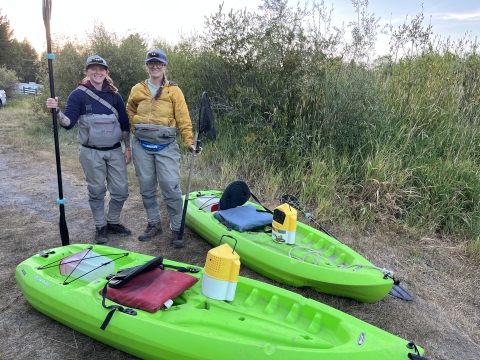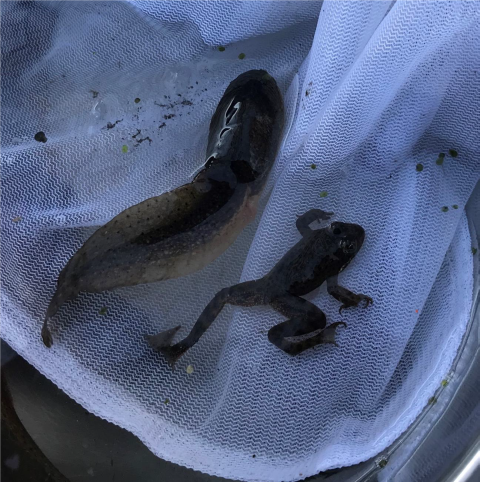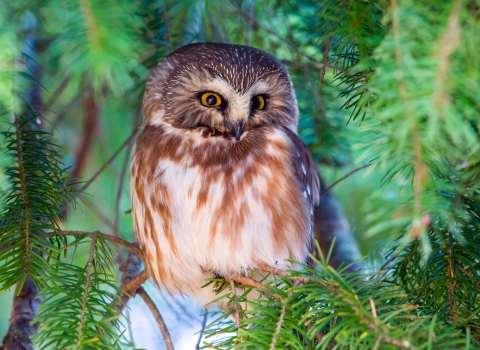By Amanda Smith, public affairs specialist, Pacific Region, U.S. Fish and Wildlife Service
“People come to Bend for the beer but you haven’t lived until you’ve gone bullfrogging,” Jodi Wilmoth says with a laugh as she talks about the leap of faith that took her from the dry and dull corporate world to the wet and wild realm of conservation in Central Oregon.“ I needed something that filled my soul,” says Wilmoth. “I had never touched a frog in my life but right there in my own backyard, on the banks of the Little Deschutes River, was work that called to me. Work that had a bigger purpose.”
Wilmoth, a native of the Pacific Northwest and a longtime project manager for a large pharmaceutical company, didn’t have a plan in place after leaving her 9 to 5 job. What she did have was a fun volunteer gig doing local invasive species invasive species
An invasive species is any plant or animal that has spread or been introduced into a new area where they are, or could, cause harm to the environment, economy, or human, animal, or plant health. Their unwelcome presence can destroy ecosystems and cost millions of dollars.
Learn more about invasive species removal, a job that fueled her drive to protect the Deschutes and piqued her interest in frogs. She followed the river and her curiosity.
“I learned that everything is connected and that a single thing like bullfrog removal could have a huge impact on the entire health of the watershed,” she says. “I have a degree in molecular biology and I love science, but getting outside of the lab and playing in the mud excited me.” Her excitement was both contagious and effective. By 2017, Wilmoth had gone from one woman hunting bullfrogs in the dark of night to a network of passionate professionals and landowners seeking to make a difference for the Deschutes River Basin. Out of this collaborative spirit, Three Rivers Environmental was born.
Three Rivers is an environmental consulting business that specializes in the state and federal permitting process for public and private entities in Washington and Oregon. Wilmoth founded Three Rivers to “act as a bridge” between on-the-ground projects and natural resource managers to ensure compliance with laws such as the Endangered Species Act.
“The Endangered Species Act is an invaluable and far-reaching conservation tool that has saved 99% of listed species from extinction in the last 50 years,” says Bridget Moran, a field supervisor in the Service’s Bend, Oregon office. “Energetic, dedicated people such as Jodi help us wield that tool in a powerful, localized way.”
It doesn’t get much more local than your own backyard. Through funding from the Deschutes River Basin Habitat Conservation Plan, Three Rivers Environmental brings people together with the shared goal of protecting the water and wildlife that connects them all. The Deschutes River Basin Habitat Conservation Plan is a dynamic and robust strategy. Spanning approximately 10,500 square miles of land across six counties in the basin, this plan reflects 12 years of scientific collaboration among water managers, biologists, hydrologists, and other stakeholders to meet the water needs of both Central Oregonians and threatened species.
While water management activities in the basin impact many species of wildlife, the conservation measures in the Deschutes River Basin Habitat Conservation Plan specifically promote conservation of the region’s most at-risk species. One of those species is the Oregon spotted frog, a species listed as threatened under the Endangered Species Act in 2014. This amphibian only occupies a small fraction of its historical range in the Pacific Northwest, but the marshy wetlands adjacent to the upper Deschutes River and its tributaries, including the Little Deschutes River, provide some of its core remaining habitat. The frogs lay their eggs in the spring, and survival to maturity depends on those eggs remaining within water.
Oregon spotted frog and their eggs face many threats to their survival, but one of the biggest and most pernicious threats comes in the form of another frog — the American bullfrog. With bodies triple the size of the spotted frog and an appetite to match, bullfrogs prey on spotted frogs and dominate viable habitat. Research shows that where bullfrogs thrive, Oregon spotted frog cannot survive.
This is where Wilmoth and her Three Rivers crew come in. “It is a prerequisite that those who join our team have both a scientific background and a sense of adventure,” says Wilmoth. Their work depends on the time of day and the time of year but “it’s never boring and pretty much always messy.” During the summer, the bullfrog control project involves day surveys for egg masses and nighttime kayak patrols for live capture, while wintertime is spent collecting larvae.
Regardless of the season, bullfrog removal — and large scale conservation in the Deschutes River Basin as a whole — is only possible with the cooperation of federal, state, and local entities. While some of the land throughout the Basin is managed by federal and state agencies, the majority of the land along the Little Deschutes River is privately owned and comprised of exactly the kind of marshy wetlands bullfrog prefer.
“The Service, Oregon Department of Fish and Wildlife, the Upper Deschutes Watershed Council, and U.S. Geological Survey are all key partners in this project, but private landowners really deserve the recognition,” says Moran. “Without the people who live in this community working with us, allowing us access to their properties, teaming up with us on restoration, we wouldn’t be able to make a difference for Oregon spotted frog or other imperiled species like bull trout, steelhead, and sockeye salmon that call this place home.”
As of earlier this year, 20 landowners with a variety of property types covering about 2,000 acres, agreed to allow access on their lands for both removal of bullfrogs and surveying of Oregon spotted frogs. The willingness of private citizens — ranging from cattle ranchers with thousands of acres to a retiree with a few acres — to open up their spaces to help conservation is something that gives Wilmoth hope for the future. “Today, it’s rare to hear news of people coming together, regardless of their differences, for something that transcends political or cultural dividing lines,” she says. “Yet here we are, getting muddy together today so that tomorrow is brighter for future generations of wildlife and people.”
That future looks to be a bit brighter already. Data from the first six years of the bullfrog removal project in the Thousand Trails pond, which is adjacent to the Little Deschutes River, indicate both a decline in adult bullfrogs and egg masses and an increase in the number of Oregon spotted frog egg masses. “This is really a testament to what the Deschutes River Basin Habitat Plan can do when it is powered by partnership,” says Moran. “A plan is just paper until people come together, roll up their sleeves, and take a leap of faith for conservation in their own backyards.”
Follow the flow of the Deschutes River into the future with this story map on the Deschutes River Basin Habitat Conservation Plan and see more photos from this article here on our Pacific Region Medium blog.
This year is the 50th anniversary of the Endangered Species Act, a law that has been a powerful catalyst for conservation of America’s most treasured fish, wildlife, plants and their habitats. In the Pacific Region, our Tribes, state and federal agencies, and partners have joined with our dedicated staff to be the driving force behind the successes we share and the strength ensuring we can address the challenges ahead. Celebrate this milestone with us in this collection of stories as we reflect on past successes, assess current challenges, and envision an equally bright future for the next 50 years and beyond.






